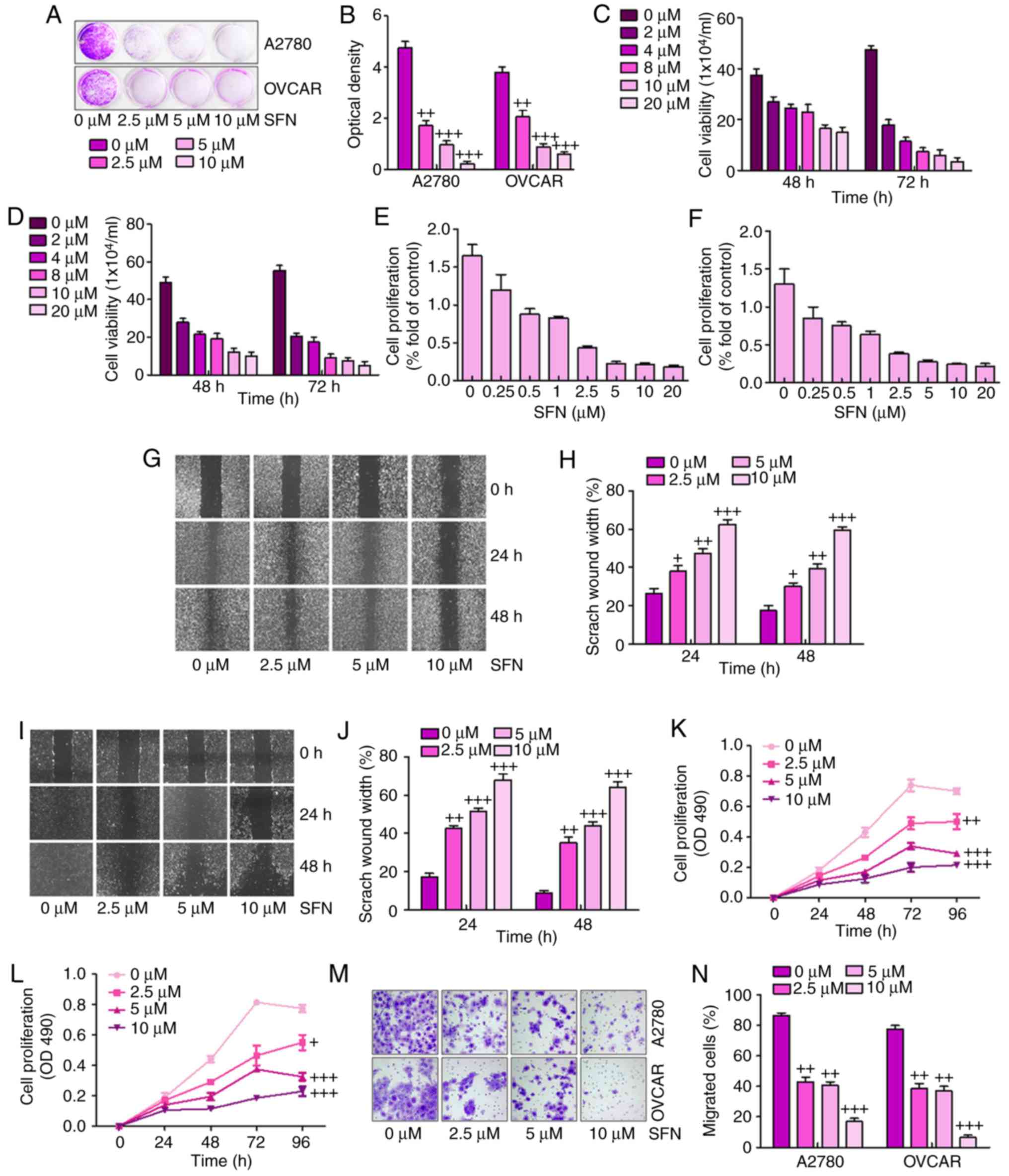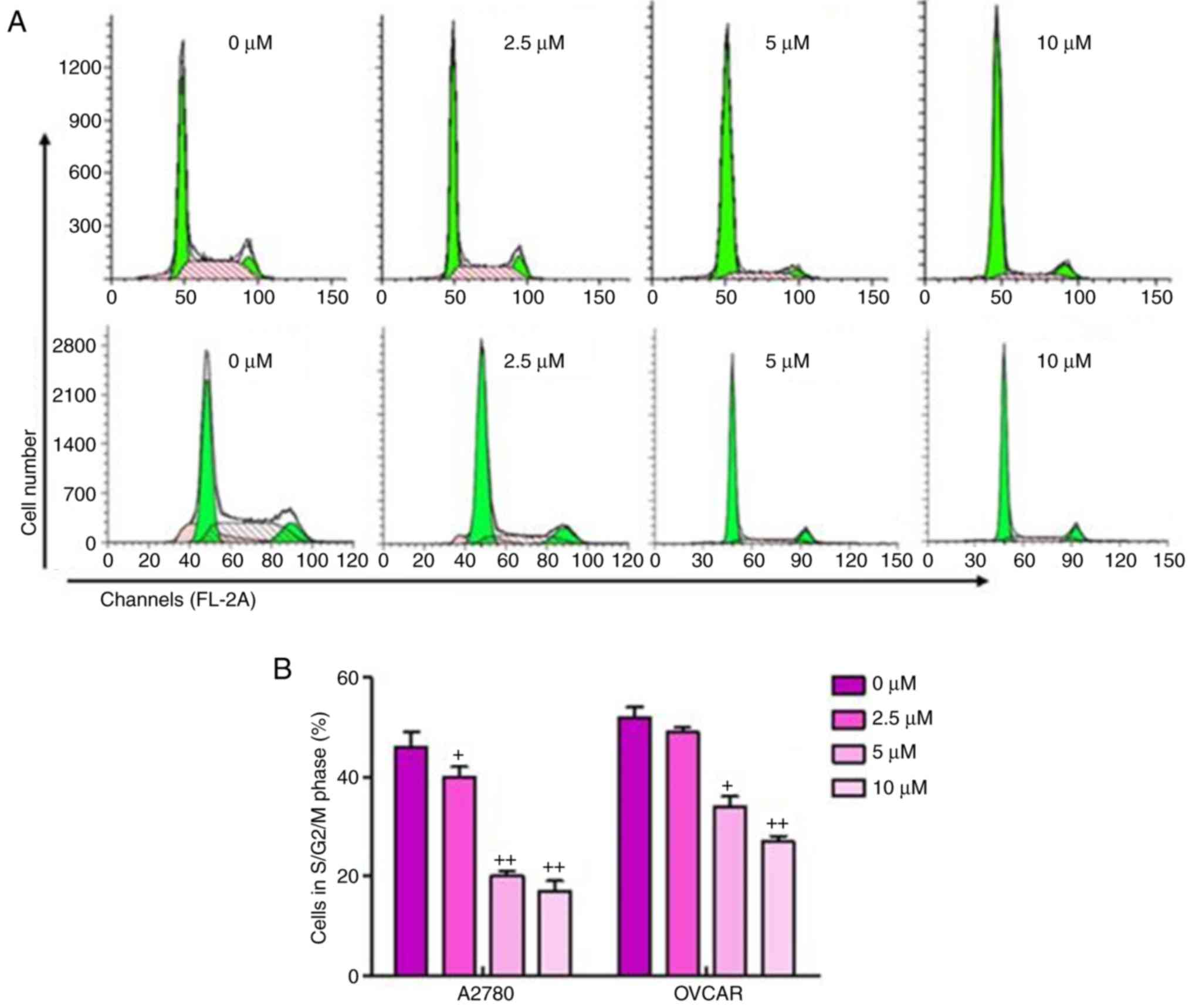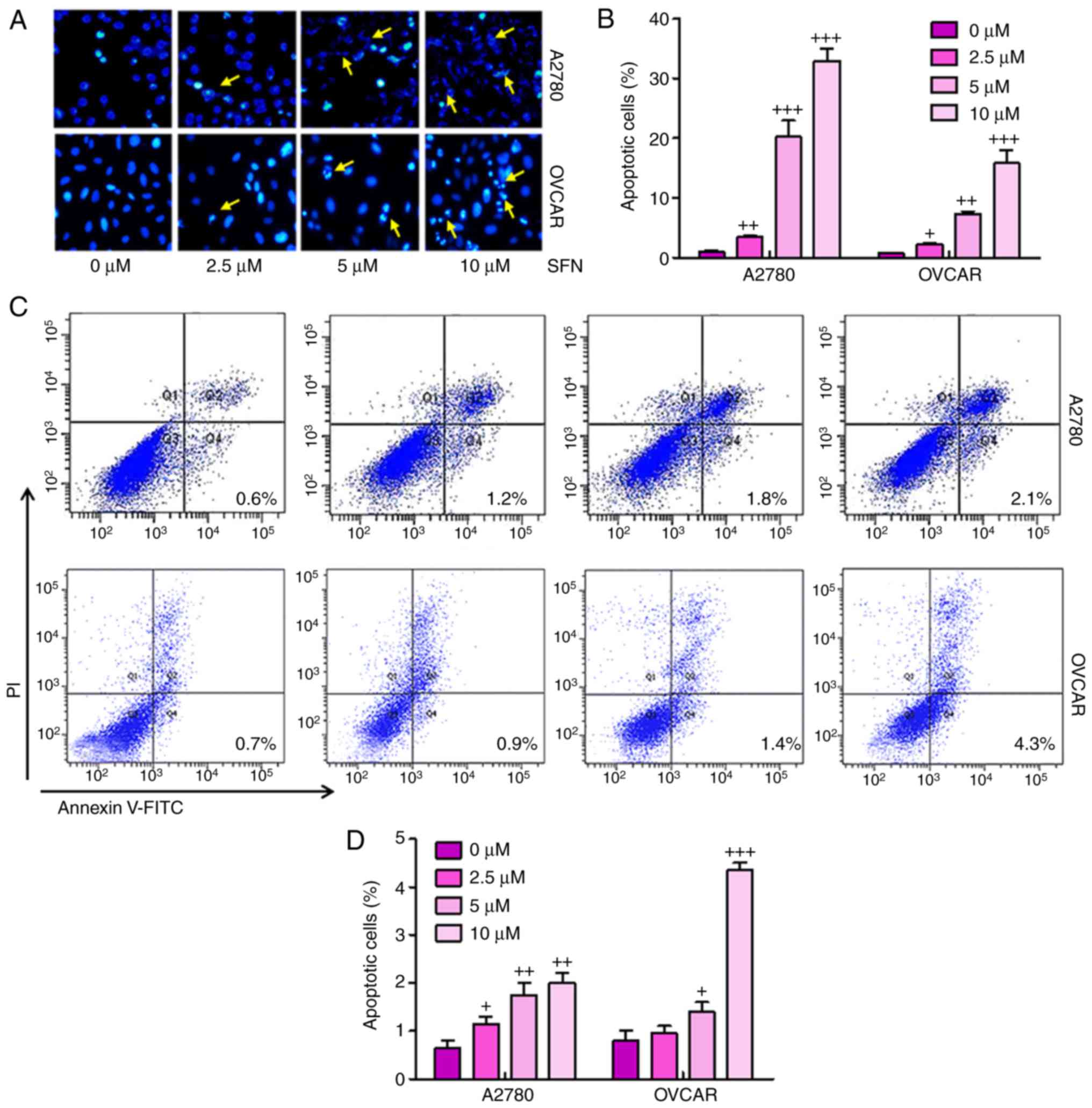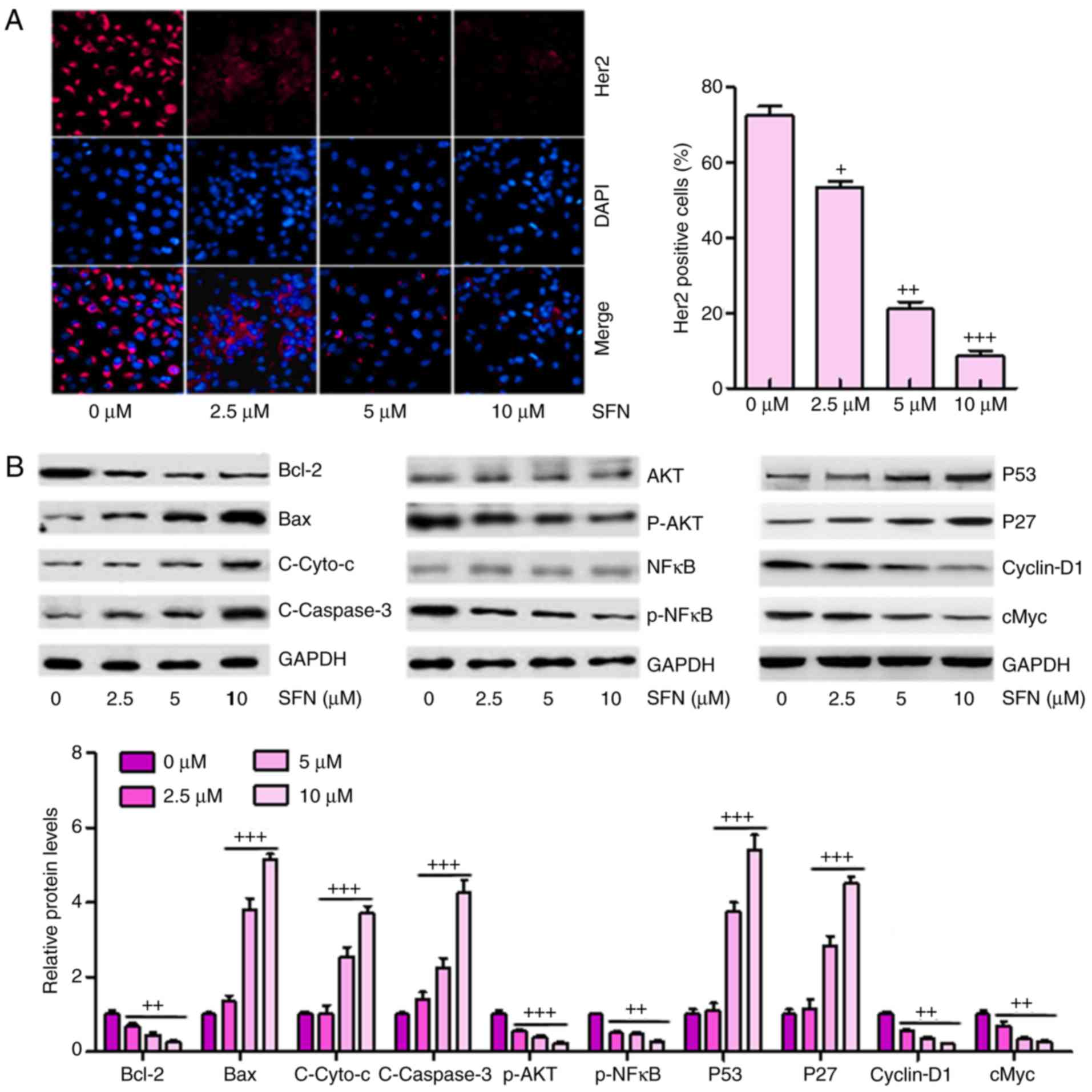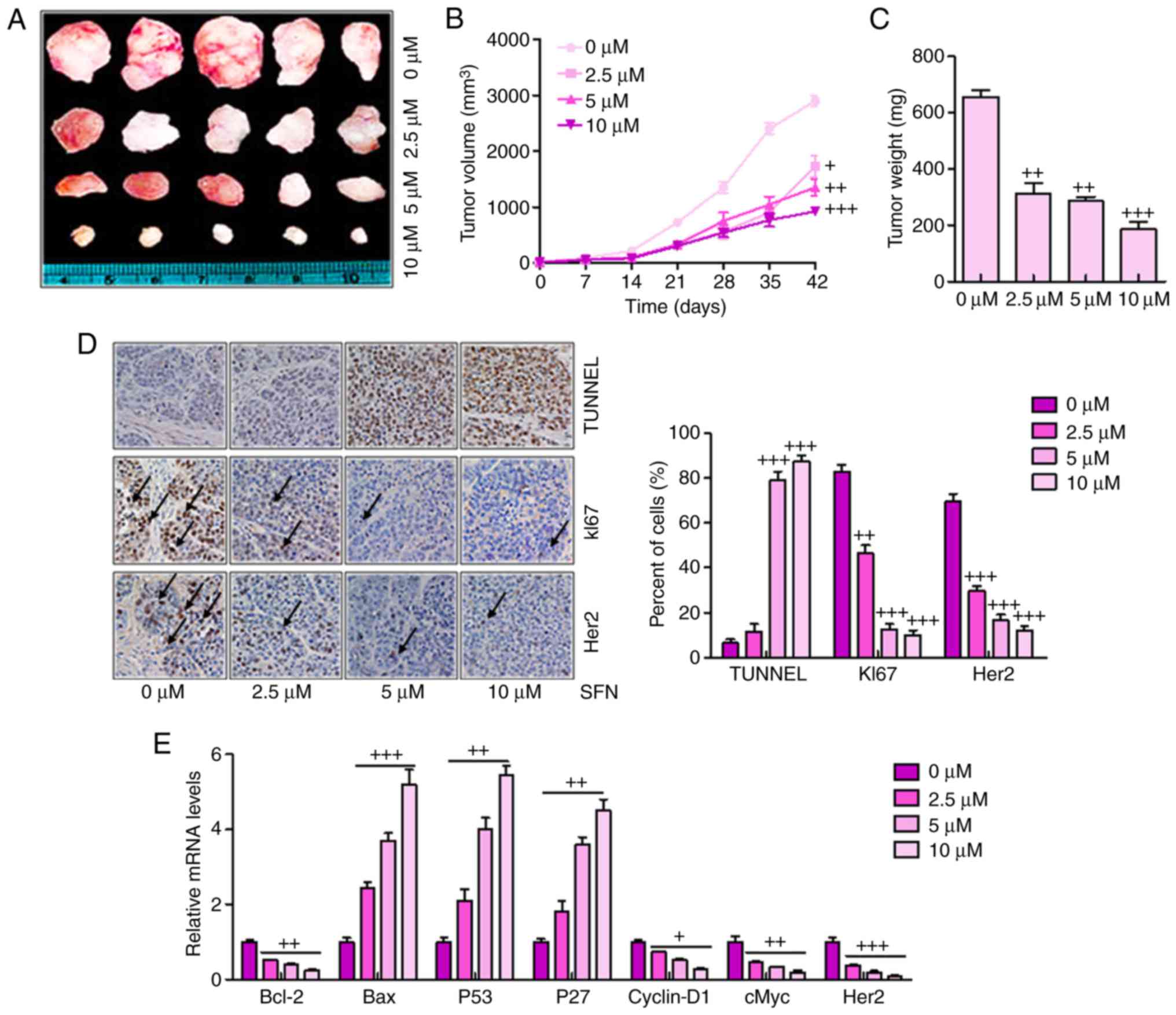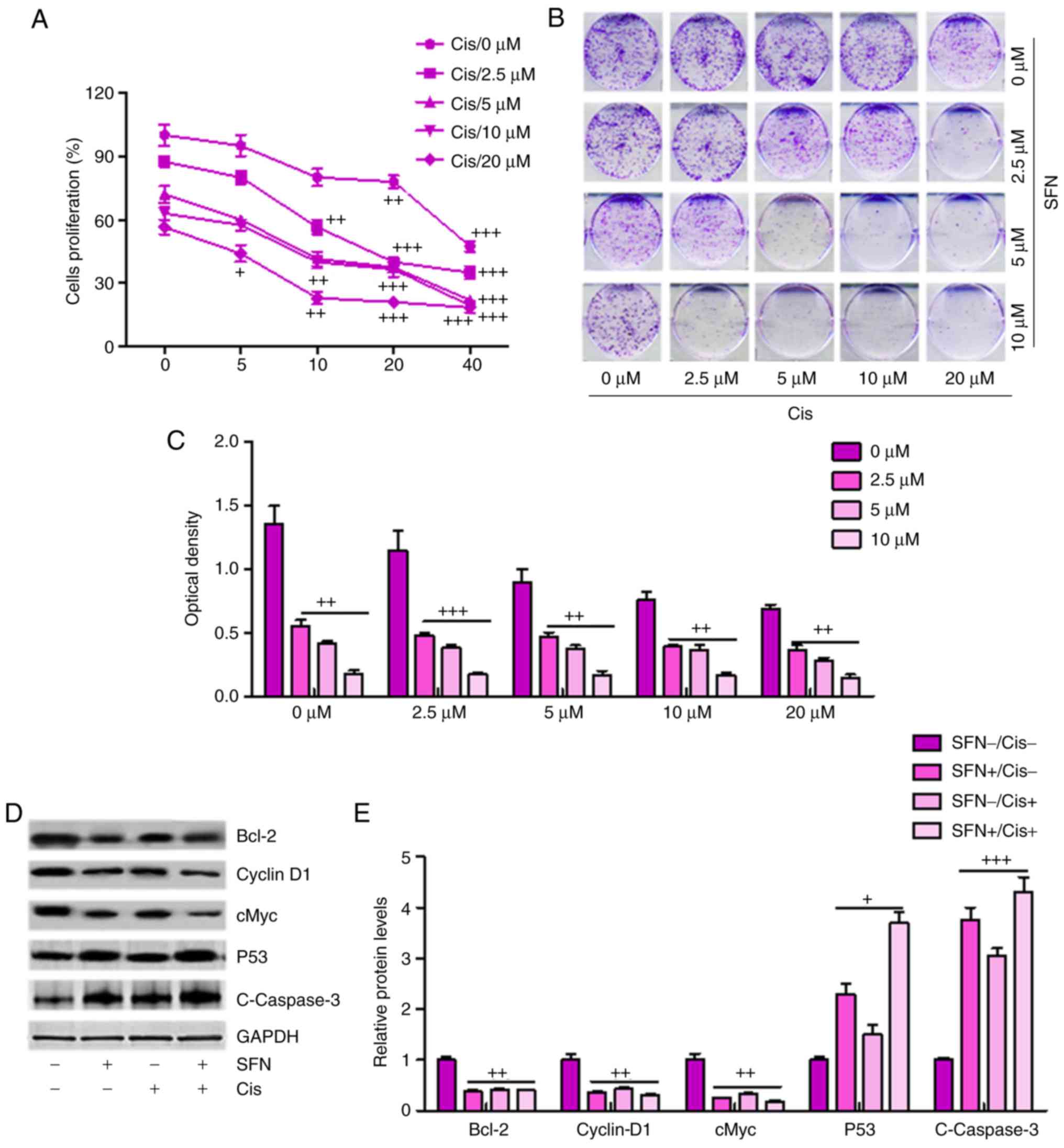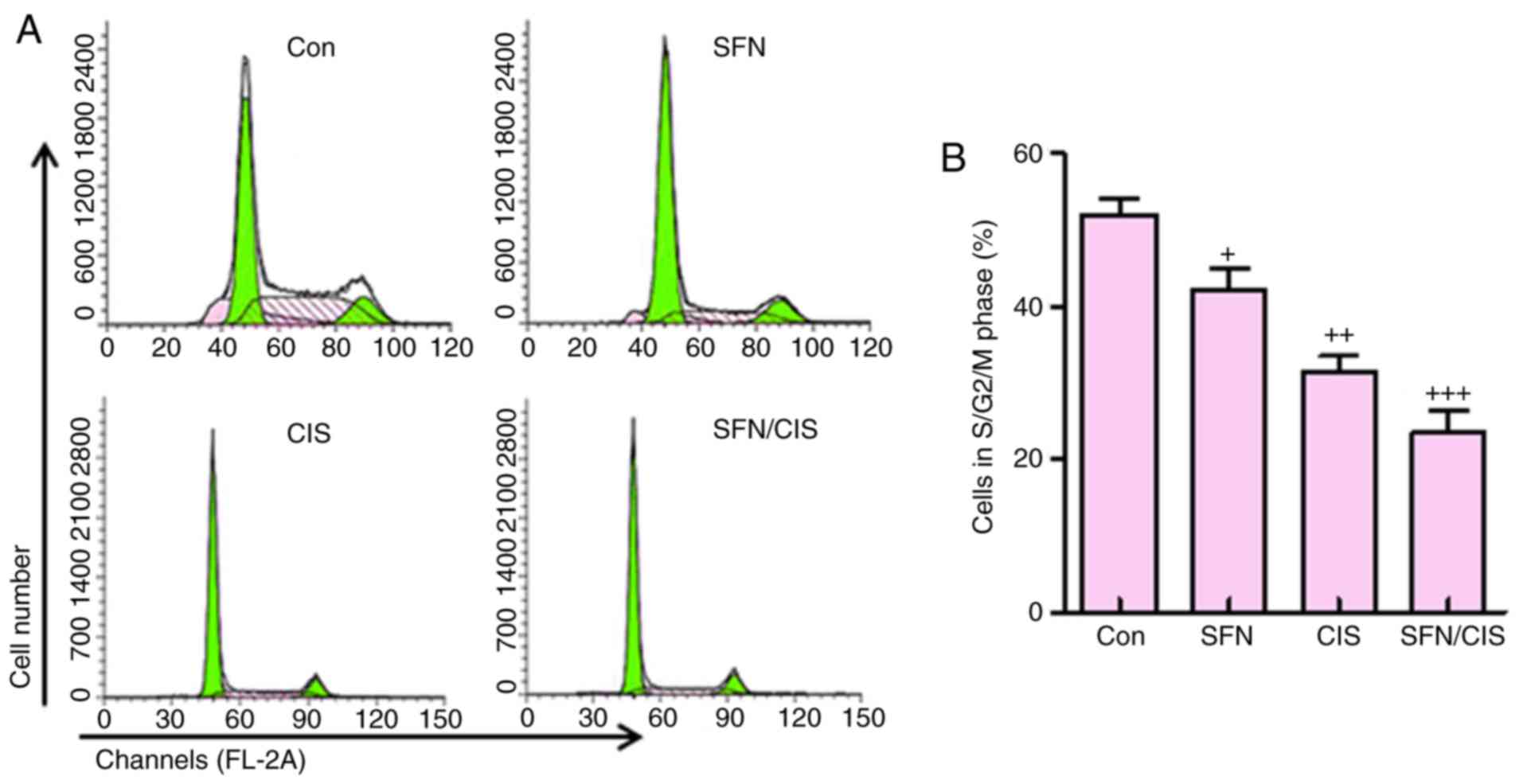Sulforaphane regulates apoptosis- and proliferation‑related signaling pathways and synergizes with cisplatin to suppress human ovarian cancer
Retraction in 10.3892/ijmm.2024.5367
- Authors:
- Published online on: September 6, 2018 https://doi.org/10.3892/ijmm.2018.3860
- Pages: 2447-2458
-
Copyright: © Kan et al. This is an open access article distributed under the terms of Creative Commons Attribution License.
Abstract
Introduction
Ovarian cancer is one important cause of gynecologic cancer-associated mortality, with an overall five-year survival rate of 45% and an overall 10-year survival rate of 35% in the USA (1,2). Globally, it is estimated that ~283,000 new cases of ovarian cancer are likely to be diagnosed in the world in 2020, with ~66% of the cases affecting women aged <65 years (3). At present, ovarian cancer treatment consists of cytoreductive surgery and platinum-based chemotherapy. However, as the disease is usually diagnosed at an advanced stage, its prognosis remains poor (4,5). Although substantial progress has been made in the research and development of novel targeted therapies for tumors or cancer in humans, including human ovarian cancer, a useful and effective alternative for drug research is the repurposing of drugs. At present, examples of this type of drug are in different stages of clinical trials (6), and improved targeted therapeutic strategies are required to inhibit the progression of ovarian cancer.
Epidemiological studies have suggested that the intake of cruciferous vegetables, including broccoli, reduces the risks for the induction of certain forms of cancer (7). The natural compound, sulforaphane, was isolated from broccoli in the early 1990s as an inducer of phase 2 enzymes (xenobiotic metabolism), and numerous studies have since proposed various anti-neoplastic pharmacological properties of sulforaphane, thereby suggesting its potential as a promising candidate in cancer chemoprevention (8–10). Pharmacokinetic investigations in rats and humans have demonstrated that sulforaphane can be distributed in the body and reach micromolar concentrations in the blood. Multiple mechanisms of action inherent to the anticancer properties of sulforaphane have been reported (11,12). Dietary consumption of cruciferous vegetables containing sulforaphane may reduce the risk of several common types of cancer, including prostate, breast, lung and colorectal cancer (13–16). For example, it can inhibit the migration and invasion of glioblastoma cells (17), and has also been considered for the treatment of cervical cancer cells (18). Additionally, sulforaphane is involved in the inhibition of breast cancer cell proliferation and the induction of apoptosis of certain cancer cell lines, including osteosarcoma (19).
The present study indicated that sulforaphane acted synergistically with the chemotherapeutic drug cisplatin to inhibit ovarian cancer cell proliferation and promote apoptosis in vitro. In the in vivo experiments, sulforaphane effectively inhibited xenograft tumor growth and progression, at least partly through inhibiting cell proliferation via cancer-related signaling pathway regulation. Therefore, these results indicated that sulforaphane offers potential and may be repurposed as an anti-human ovarian cancer agent. However, further investigations are required to examine the anticancer role of sulforaphane in preclinical and clinical trials in the future.
Materials and methods
Cell culture and treatment
The human ovarian cancer cell lines, A2780 and OVCAR, were purchased from the American Type Culture Collection (Manassas, VA, USA) and the Cell Resource Center, Shanghai Institute of Biochemistry and Cell Bank at the Chinese Academy of Sciences (Shanghai, China). The cell lines were routinely authenticated by DNA-fingerprinting and isoenzyme analyses, and checked for contamination by mycoplasma using Hoechst staining. All cell lines were maintained in Roswell Park Memorial Institute-1640 (Gibco; Thermo Fisher Scientific, Inc., Waltham, MA, USA), Dulbecco's modified Eagle's medium or Minimum Essential Medium, containing 10% fetal bovine serum (FBS; Gibco; Thermo Fisher Scientific, Inc.), 100 μg of streptomycin and 100 units of penicillin. A2780 were cultured in RPMI-1640 medium and OVCAR cells in DMEM medium. The cells were incubated at 37°C with 5% CO2. The sulforaphane chemical was obtained from Hangzhou Lin'an Tianhong Bio-Tech Co., Ltd. (Hangzhou, China).
Colony formation and migration assay
The human ovarian cancer cells were suspended in 0.9% methylcellulose-based semisolid medium MethoCult H4100 (StemCell Technologies, Inc., Beijing, China), with 1,000 cells seeded in 3.5 cm dishes, and treated with 0, 2.5, 5 or 10 μM sulforaphane or ethanol control, and maintained at 37°C. After 14 days, individual primary clones (450 cells) were trypsinized and replated in the same conditions to examine the secondary colony forming ability for self-renewal. For the Transwell migration assays, 10×104 cells were planted in the top chamber with a non-coated membrane. The cells were seeded in serum-free medium, and a medium containing 10% serum used as a chemoattractant in the lower chamber. The cells were then incubated for 16 h at 37°C and 5% CO2 in a tissue culture incubator. After 16 h, the non-migrated cells were removed from the upper sides of the Transwell membrane filter inserts with cotton-tipped swabs. The migrated cells on the lower sides of the inserts were then stained with Giemsa, and the cells were counted under a Nikon Eclipse Ti2 inverted microscope (Nikon Corporation, Tokyo, Japan).
Cell viability assay
The viable cancer cells were determined via Trypan blue exclusion staining analysis. In brief, the A2780 and OVCAR cells were administrated with sulforaphane at the indicated concentrations or with the vehicle control. After 48 and 72 h, the cells were collected through trypsin dissociation, and then stained with Trypan blue until a final concentration of 0.1% Trypan blue. The unstained viable cancer cells were then counted under a bright field microscope. The assay was performed in triplicate.
Cell proliferation assay
The ovarian cancer cell proliferation was measured using Premixed WST-1 reagent (Roche Diagnostics, Basel, Switzerland). In brief, the A2780 and OVCAR cells were seeded in 96-well plates, and were treated with sulforaphane and/or other drugs at the indicated concentrations for 24 or 48 h. WST-1 reagent (10 μl) was then administrated to each well, which was followed by incubation at 37°C for 30–60 min. The wells were finally read at 440 nm using the microplate reader (Thermo Fisher Scientific, Inc.). The assay was performed in triplicate.
Cell wound healing assay
When the A2780 cells reached 95% confluence, they were wounded with micro-pipette tips and treated with sulforaphane at the indicated concentrations. The measurement of the wound gap was recorded at 0, 24 and 48 h following sulforaphane treatment under bright field microscopy. The assay was performed in triplicate.
Analysis of apoptosis using Hoechst 33258 staining
The A2780 and OVCAR cells were treated with the various concentrations of sulforaphane or ethanol control. After 24 h, the cells were collected, and fixed and stained with Magic Solution containing 10X stock of 0.5% NP-40, 3.4% formaldehyde and 10 μg/ml Hoechst 33258 in PBS. The apoptotic cells were determined and recorded using a fluorescence microscope. The assay was performed in triplicate. The average number of apoptotic ovarian cancer cells was evaluated by counting the apparent apoptotic cells in 10 randomly selected fields at ×100 magnification for each condition.
Flow cytometric analysis
A flow cytometric assay was used to clarify the apoptotic cells and cell cycle arrest following sulforaphane treatment. Following treatment with sulforaphane for 48 h, the ovarian cancer cells were collected with trypsinization and then washed twice with PBS, fixed in cold 80% ethanol, and finally stored at 4°C overnight. The cells were then washed twice with PBS, and RNase A (10 mg/ml) was administrated for analysis. Propidium iodide (PI) was then added at a concentration of 0.05 mg/ml and incubated for 20 min at 4°C in the dark. The FITC-labeled Annexin V/PI staining was applied according to the manufacturer's protocol (Nanjing Keygen Biotech Co., Ltd., Nanjing, China). In brief, 1×106 cells in each well were suspended with buffer containing FITC-conjugated Annexin V/PI. The samples were then analyzed using flow cytometry.
Immunofluorescence assay
Following induction with the conditioned culture medium, the cells were fixed in 4% paraformaldehyde, and permeabilized with 0.1% Triton X-100 in PBS containing 0.5% BSA (Sigma-Aldrich; Merck KGaA, Darmstadt, Germany) for 30 min. The cells at 70–80% confluence were subsequently incubated with antibodies against human epidermal growth factor receptor 2 (Her2; 1:200; 4290; Cell Signaling Technology, Inc., Danvers, MA, USA) for 30 min at room temperature, followed by labeling with Alexa Fluor 488-conjugated rabbit anti-mouse IgG antibody at room temperature in the dark for 30 min (A27023; 1:1,000 Thermo Fisher Scientific, Inc.). The cells were viewed under a fluorescent microscope.
Immunohistochemical (IHC) assay
The sections (6 μm) of the paraffin-embedded tumor tissue blocks were deparaffinized and rehydrated. The tumor tissue samples were incubated with primary monoclonal antibodies against Her2 and KI67 (1:200; 9449; Cell Signaling Technology, Inc.) at 4°C overnight. The slide was then gently rinsed with PBS and developed using the Envision system/HRP for 30 min and substrate-chromogen for 15 min at room temperature. The nuclei were counterstained with Mayer's hematoxylin (MHS1-100ML; Sigma-Aldrich; Merck KGaA) under an Eclipse TE2000E inverted microscope (Nikon Corporation).
Analysis of apoptosis using terminal deoxynucleotidyl transferase-mediated dUTP nick end labeling (TUNEL)
The analysis of apoptosis in the tissue samples was determined by TUNEL using an in situ cell death detection kit, Fluorescein (Roche Applied Science, Madison, WI, USA) according to the manufacturer's protocol. The number of TUNEL-positive cells was counted under a fluorescence microscope. The percentages of apoptotic cells were calculated from the ratio of apoptotic cells to total cells counted. The tissue sections were counter-stained with hematoxylin, mounted and observed under light microscopy. The experiment was performed three times independently for each cell line.
Western blot analysis
Cell proteins from the ovarian cancer cells were extracted using a T-PER Tissue Protein Extraction Reagent kit (Thermo Fisher Scientific, Inc.) according to the manufacturer's protocol. The protein concentrations were determined using a BCA protein assay kit, and equal quantities of protein (40 μg) were loaded per well on a 10% sodium dodecyl sulphatepolyacrylamide gel. Subsequently, the proteins were transferred onto a polyvinylidene difluoride membrane. The resulting membrane was blocked with Tris-buffered saline containing 0.05% Tween-20 (TBS-T), supplemented with 5% skimmed milk (Sigma-Aldrich; Merck KGaA) at room temperature for 2 h on a rotary shaker, and followed by TBS-T washing. The membrane was incubated with specific primary antibodies, diluted in TBST, at 4°C overnight. Subsequently, the membrane was washed with TBS-T followed by incubation with the goat anti-rabbit peroxidase-conjugated secondary antibody (1662408edu; 1:2,000; Bio-Rad Laboratories, Inc., Hercules, CA, USA) at room temperature for 1 h. The immunoreactive proteins were detected using an enhanced chemiluminescence western blotting detection kit. The western blot bands were observed using the GE Healthcare ECL Western Blotting Analysis system (GE Healthcare Life Sciences, Chalfont, UK) and exposed to x-ray film (Kodak, Rochester, NY, USA). The primary antibodies used were: Rabbit anti-P53 (cat. no. 2527), anti-Bcl-2 (cat. no. 3498), anti-phosphorylated nuclear factor-κB (p-NF-κB; cat. no. 3033), anti-cMyc (cat. no. 5605), anti-AKT (cat. no. 4685) and anti-p-AKT (cat. no. 4060) from Cell Signaling Technology, Inc.; rabbit anti-Bcl-2-associated X protein (Bax; cat. no. ab32503), anti-NF-κB (cat. no. ab16502), anti-Caspase-3 (cat. no. 13847), anti-Cyclin-D1 (cat. no. 134175) and mouse anti-P27 (cat. no. 193379) from Abcam (Cambridge, MA, USA); and rabbit anti-cytochrome c (cyto-c; cat. no. sc-13561) and anti-GAPDH (cat. no. sc-47724) from Santa Cruz Biotechnology, Inc. (Dallas, TX, USA). All antibodies were used at a dilution of 1:1,000, with the exception of anti-GAPDH (1:500).
Reverse transcription-quantitative polymerase chain reaction (RT-qPCR) analysis
Total RNA from the cultured cells and tissue samples was isolated using the mirVana miRNA isolation kit (Ambion; Thermo Fisher Scientific, Inc.) based on the manufacturer's protocol. The cDNA was then synthesized from total RNA with the Taqman miRNA reverse transcription kit (Applied Biosystems; Thermo Fisher Scientific, Inc.). The RT-qPCR analysis was performed using the Applied Biosystems 7500 Sequence Detection system with iQ™ SYBR-Green SuperMix (Bio-Rad Laboratories, Inc.) containing 5 ng cDNA and 10 pM of each primer. The PCR cycles were 95°C for 5 min, then 95°C for 20 sec and 60°C for 60 sec for 40 cycles. The annealing, extension and also the data reading were at 60°C. The data were normalized to the geometric mean of housekeeping gene GAPDH. The data were analyzed with 2-ΔΔCq method (20). The sequences of the primers are summarized in Table I.
Table ISequences of primers used for reverse transcription-quantitative polymerase chain reaction in the present study. |
Xenograft tumor models of human ovarian cancer cells
The use and care of animals as models were approved by the Institutional Animal Care and Use Committee of Zaozhuang City Hospital (Zaozhuang, China). All experimental procedures were performed according to the approved guidelines. The mouse experiments were performed in the Animal Laboratory Center at Zaozhuang City Hospital. The cells (1×107cells) treated with various concentrations of sulforaphane, described above, were suspended in 100 μl serum-free medium and injected subcutaneously into the left flank of 4–6-week-old male BALB/c nu/nu nude mice (15–18 g), with 8 mice in each groups, 32 mice in total, were injected with cells. The mice were raised in the SPF animal facility with sterile food and water ad libitum, at 20°C with a 50% humidity and a 12-h light/dark cycle. Tumor size was measured with digital calipers and calculated every week. Tumor volume was measured every 7 days and at the end (~6 weeks) of treatment, when the mice were sacrificed. The tumors were excised, weighed, fixed in 10% neutral formalin, and embedded in paraffin for histological analysis under an Eclipse TE2000E inverted microscope (Nikon Corporation).
Statistical analysis
The differences of indices are presented as the mean ± standard error of the mean using the data. The treated tissue and the corresponding controls were compared using GraphPad Prism (version 6.0; GraphPad Software, Inc., La Jolla, CA, USA) using one-way analysis of variance with Dunn's least significant difference test. P<0.05 was considered to indicate a statistically significant difference.
Results
Sulforaphane effectively suppresses human ovarian cancer cell proliferation
The present study attempted to examine the effect of the sulforaphane on the proliferative activity of A2780 and OVCAR human ovarian cancer lines. The A2780 and OVCAR cells were inhibited by increasing concentrations of sulforaphane. The crystal violet staining suggested that sulforaphane effectively suppressed cell proliferative activity in the A2780 and OVCAR cells at different concentrations between 2.5 and 10 μM (Fig. 1A and B). The direct cell numbers following growth of A2780 and OVCAR cells administrated with different concentrations of sulforaphane (0–20 μM) were also investigated. The results showed that the number of viable cells was significantly downregulated when the sulforaphane concentration increased in the A2780 (Fig. 1C) and OVCAR (Fig. 1D) cell lines at 48 and 72 h. Further calculation of anti-proliferative effects was achieved through the WST-1 proliferation assay, which indicated that significant cell proliferation suppression occurred at varying concentrations of sulforaphane in the A2780 (Fig. 1E) and OVCAR (Fig. 1F) cell lines. Together, these results demonstrated that sulforaphane effectively inhibited ovarian cancer cell proliferation.
Subsequently, the present study examined whether sulforaphane has any effect on ovarian cancer cell migration or wound healing. The monolayer cells of A2780 and OVCAR were wounded and treated with different concentrations of sulforaphane. The width of the gap of the wound defect, relative to the starting width, was determined for A2780 cells at 24 and 48 h (Fig. 1G and H). The data suggested that the scratch wound healing width was increased following 2.5, 5 and 10 μM sulforaphane administration. Similarly, compared with the 0 h group without sulforaphane treatment, the scratch wound healing width was altered significantly in the OVCAR cells in the presence of sulforaphane at 24 and 48 h (Fig. 1I and J). These results indicated that sulforaphane suppressed ovarian cancer cell migration and proliferation in a dose-dependent manner.
To further examine the effects of sulforaphane on ovarian cancer cell lines, MTT and Transwell assays of the migration of cancer cells were performed for the A2780 and OVCAR cells. The results suggested that, compared with the cells in the absence of sulforaphane, the proliferation ability of the A2780 (Fig. 1K) and OVCAR (Fig. 1L) cells were significantly inhibited by sulforaphane treatment at different concentrations. The Transwell assays indicated that sulforaphane treatment significantly suppressed the migrated ovarian cancer cells, particularly at the highest concentration of sulforaphane (Fig. 1M and N). These results indicated that administration with sulforaphane was able to inhibit the proliferation, migration and metastasis of human ovarian cancer cells.
The present study also performed cell cycle analysis on the sulforaphane-treated ovarian cancer cells and found a significant upregulation in cancer cells arrested in the G1 phase, and downregulation of cells in the S/M phase in sulforaphane-treated A2780 and OVCAR cells, relative to the cells without sulforaphane administration (Fig. 2A and B). These results suggested that the inhibitory effect of sulforaphane on ovarian cancer cell proliferation may be due, at least partly, to the inhibition of cell cycle development and progression.
Sulforaphane suppresses ovarian cancer progression via promotion of apoptosis
To illustrate the possible mechanisms underlying sulforaphane-induced cell proliferation inhibition of ovarian cancer, the present study examined whether sulforaphane can induce apoptosis in ovarian cancer cell lines. When the proliferating A2780 and OVCAR cells were treated with 2.5, 5 and 10 μM sulforaphane for 24 h and then stained with Hoechst 33,258, the numbers of apoptotic cancer cells were significant (Fig. 3A and B). Furthermore, flow cytometry was used to evaluate the apoptotic levels in A2780 and OVCAR cells. As shown in Fig. 3C and D, the number of apoptotic cells were higher in the cells with sulforaphane administration in a dose-dependent manner, indicating that sulforaphane may be involved in enhancing apoptosis in ovarian cancer development. Quantitative analysis of the ovarian cancer cells indicated that the percentages of apoptotic cells were significantly upregulated in the sulforaphane-treated A2780 and OVCAR groups, with a significant difference. These data indicated that the sulforaphane-induced suppression of A2780 and OVCAR cells was due to the induction of apoptosis.
Sulforaphane inhibits multiple cancer development-associated signaling pathways in A2780 cells
The high expression of Her2 is a marker for tumor progression in the development of several types of cancer according to previous studies (21). In order to calculate whether there was a similar effect in ovarian cancer cells, immunofluorescent assays were used to analyze the expression levels of Her2 in different groups of A2780 cells. A marked elevation in Her2 staining was observed in cells without sulforaphane administration, and this was significantly suppressed by sulforaphane in a dose-dependent manner (Fig. 4A). These results confirmed that sulforaphane inhibited the expression of Her2 in ovarian cancer cells, as previously indicated (22).
Subsequently, the present study attempted to determine which, if any, cancer-involved signaling pathways were regulated by sulforaphane. A total of 10 cancer-associated signaling pathways were examined via western blot analysis according to previous studies (23–25). It was found that Bcl-2, an anti-apoptotic factor, was significantly inhibited under sulforaphane administration. However, Bax, Cyto-c and Caspase-3 were upregulated in cells in the presence of different concentrations of sulforaphane in a dose-dependent manner, contributing to the apoptosis of cancer cells. In addition, AKT and NF-κB, as important regulators of cell proliferation, were inactivated in ovarian cancer cells under sulforaphane administration. P53 and P27 were upregulated following sulforaphane treatment in the A2780 cells, which suppressed cancer cell cycle, consistent with a previous study (26). Furthermore, Cyclin-D1 and cMyc were inhibited following sulforaphane induction at 2.5, 5 and 10 μM (Fig. 4B).
Sulforaphane effectively suppresses tumor growth and progression in a xenograft model of human ovarian cancer cells
The present study also examined the anticancer effect of sulforaphane in an in vivo xenograft tumor model of human ovarian cancer. A2780 cells in the presence or the absence of sulforaphane at different concentrations were injected subcutaneously into the flanks of athymic nude mice. Following injection, tumor growth was observed and monitored for up to 42 days (Fig. 5A). Smaller tumor volumes and tumor weights were found in the sulforaphane-treated groups, compared with those in the groups without sulforaphane administration (Fig. 5B and C). Histologic evaluation was also performed on the retrieved tumor samples. Immunohistochemical staining with the TUNEL, KI67 and Her2 antibodies indicated a significant increase in the number of TUNEL-positive cells in the sulforaphane treatment groups, particularly at the highest dose of sulforaphane, compared with the control group (Fig. 5D). By contrast, the expression levels of KI67 and Her2 expression were reduced by sulforaphane treatment, which was consistent with earlier results and support the hypothesis that Her2 may serve as a key cellular target for sulforaphane in human ovarian cancer inhibition. Finally, RT-qPCR analysis was used to confirm the tumor progression-associated signals. Similar to the previous data, it was found that Bcl-2, Cyclin-D1, cMyc and Her2 were significantly downregulated following sulfora-phane administration. Bax, P53 and P27 were upregulated following sulforaphane treatment.
Sulforaphane synergizes with cisplatin in suppressing cancer cell proliferation and promoting apoptosis in ovarian cancer cells
If sulforaphane is to be targeted as an anti-ovarian cancer agent, it is important that sulforaphane can synergize with presently-used chemotherapeutic drugs, including cisplatin, in order to suppress cancer cell proliferation and progression. When the A2780 cells were administrated with different concentrations of sulforaphane or cisplatin, ovarian cell proliferation inhibition was observed in a dose-dependent manner (Fig. 6A), and this synergism was confirmed by a colony formation assay (Fig. 6B and C). Additionally, western blot analysis demonstrated that a combination of sulforaphane and cisplatin further decreased the levels of Bcl-2, Cyclin-D1 and cMyc, whereas P53 and cleaved Caspase-3 were significantly upregulated in the group treated with the combination of sulforaphane and cisplatin, promoting cell death (Fig. 6D and E). Therefore, these results indicated that sulforaphane synergized with cisplatin by suppressing proliferation and promoting apoptosis of human ovarian cancer.
In addition, as shown in Fig. 7A and B, sulforaphane significantly downregulated the proportion of cells in the S/G2/M phases, compared with the control group, which was consistent with previous data (8). Cisplatin further reduced the number of cells in this phase. Of note, the combination of sulforaphane and cisplatin exhibited the most marked effect on the suppression of cells in the S/G2/M phase. These data suggested that sulforaphane synergized with cisplatin to inhibit ovarian cancer cell proliferation by regulating cell cycle.
Discussion
Among all types of gynecologic cancer, human ovarian cancer is reported to be a life-threatening disease and a major contributor to cancer-associated mortality rates in females across the world (27,28). Human ovarian cancer is known to be asymptomatic or exhibit vague symptoms during the early stage; therefore, a large number of cases of ovarian cancer are detected at advanced stages, with cancer cells spreading beyond the site of the primary tumor (29). Currently, the standard therapeutic treatment for human ovarian cancer is limited to the combination of chemotherapy and surgery (30,31). Therefore, understanding the mechanism of metastasis and identifying novel strategies to inhibit ovarian cancer is important for improving clinical outcomes.
Sulforaphane has been shown to suppress cell cycle progression and induce apoptosis in pre-cancerous and tumor cells of different origin (9,11,13–16). This anticancer agent at a concentration of 75 μM was shown to cause G1/G2 cell cycle arrest and induce apoptosis by downregulating the expression of anti-apoptotic Bcl-2 and increasing the expression of apoptosis-inducing Bax in colon cancer cells (32,33). In the present study, it was found that the number of cells in the S/G2/M phase was reduced due to sulforaphane administration, leading to the cell death in human ovarian cancer. Additionally, apoptosis was induced as determined via flow cytometry, and western blot analysis revealed the downregulation of Bcl-2 and upregulation of Bax and cleaved Caspase-3, which are important regulators contributing to apoptosis. Therefore, the data suggested that sulforaphane inhibited ovarian cancer progression through inducing apoptosis.
Sulforaphane can also suppress the proliferation of bladder cancer cells, leading to the inhibition of cell proliferation and downregulated expression of NF-κB (34,35). In the present study, it was found that sulforaphane was successful in suppressing ovarian cancer cell proliferation. P53 and P27 are known essential antitumor factors. The P53 tumor suppressor gene encodes a nuclear protein, which is crucial in cell cycle regulation and major early events in cancer progression (36). P27 is a member of the Cip/Kip family of cyclin-dependent kinase inhibitors, which can induce cell cycle arrest and serve as a tumor suppressor (37). Cyclin-D1, a regulatory kinase subunit that is selectively associated with cyclin-dependent kinase 4, is a crucial modulator in the cell cycle of cancer or tumor formation (38). The oncogene cMyc is a known target gene, which is involved in cell proliferation and cell cycle (39,40). In the present study, it was found that sulforaphane suppressed the progression of ovarian cancer via the promotion of P53 and P27. By contrast, Cyclin-D1 and cMyc were downregulated following sulforaphane treatment. These data suggested that the sulforaphane-inhibited progression of ovarian cancer was associated with the upregulation of P53 and P27, and the downregulation of Cyclin-D1 and cMyc. In addition, AKT and NF-κB were suppressed following sulforaphane administration, contributing to the apoptosis of ovarian cancer cells (41).
Of note, sulforaphane synergized with cisplatin to further suppress human ovarian cancer. The results of the present study indicated that sulforaphane had a potential role in suppressing human ovarian cancer development via the inhibition of proliferation and induction of apoptosis. However, following combination with cisplatin, the cell proliferation was further suppressed, compared with that following sulforaphane or cisplatin treatment alone. In addition, western blot analysis indicated that Bcl-2, Cyclin-D1 and cMyc were inhibited following treatment with sulforaphane and cisplatin together. The levels of P53 and cleaved Caspase-3 were significantly upregulated, compared with those in the cells treated with sulforaphane or cisplatin alone.
Taken together, the present study investigated the potential effect of repurposing sulforaphane as an essential anticancer agent for the suppression of human ovarian cancer. The results indicated that sulforaphane effectively suppressed ovarian cancer cell proliferation, migration and cell cycle progression, and induced apoptosis. Sulforaphane was found to target multiple tumor- or cancer-related signaling pathways, including Bcl-2, Caspase-3, AKT, NF-κB and P53/P27, and suppressed the expression of Cyclin-D1 and cMyc in human ovarian cancer cells. Sulforaphane was also found to act synergistically with the chemotherapeutic drug cisplatin to suppress ovarian cancer cell proliferation and promote apoptosis. The in vivo xenograft model experiments further confirmed that sulforaphane effectively suppressed xenograft tumor size and weight by inhibiting cancer cell proliferation via reducing cancer-related signals. Therefore, the results indicated that sulforaphane may be repurposed as an important anti-ovarian cancer agent. However, investigations are required to further examine the anticancer role of sulforaphane in preclinical and clinical studies in the future.
Funding
Not applicable.
Availability of data and materials
All data generated or analyzed during this study are included in this published article.
Authors' contributions
JW and SK designed and analyzed the data. JW wrote the manuscript. GS performed the flow cytometry experiments. SK performed all the other experiments. All authors read and approved the final manuscript.
Ethics approval and consent to participate
The use and care of animals as models were approved by the Institutional Animal Care and Use Committee of Zaozhuang City Hospital (Zaozhuang, China). All experimental procedures were performed according to the approved guidelines.
Patient consent for publication
Not applicable.
Competing interests
The authors declare that they have no competing interests.
Acknowledgments
Not applicable.
References
|
Kamieniak MM, Muñoz-Repeto I, Rico D, Osorio A, Urioste M, García-Donas J, Hernando S, Robles-Díaz L and Ramón Y: DNA copy number profiling reveals extensive genomic loss in hereditary BRCA1 and BRCA2 ovarian carcinomas. Br J Cancer. 108:1732–1742. 2013. View Article : Google Scholar : PubMed/NCBI | |
|
Pruthi S, Gostout BS and Lindor NM: Identification and management of women with BRCA mutations or hereditary predisposition for breast and ovarian cancer. Mayo Clin Proc. 85:1111–1120. 2010. View Article : Google Scholar : PubMed/NCBI | |
|
Chester C, Dorigo O, Berek JS and Kohrt H: Immunotherapeutic approaches to ovarian cancer treatment. J Immunother Cancer. 3:72015. View Article : Google Scholar : PubMed/NCBI | |
|
Gnjatic S, Ritter E, Büchler MW, Giese NA, Brors B, Frei C, Murray A, Halama N, Zörnig I, Chen YT, et al: Seromic profiling of ovarian and pancreatic cancer. Proc Natl Acad Sci USA. 107:5088–5093. 2010. View Article : Google Scholar : PubMed/NCBI | |
|
Vaughan S, Coward JI, Bast RC Jr, Berchuck A, Berek JS, Brenton JD, Coukos G, Crum CC, Drapkin R, Etemadmoghadam D, et al: Rethinking ovarian cancer: Recommendations for improving outcomes. Nat Rev Cancer. 11:719–725. 2011. View Article : Google Scholar : PubMed/NCBI | |
|
Frampton JE: Olaparib: A review of its use as maintenance therapy in patients with ovarian cancer. BioDrugs. 29:143–150. 2015. View Article : Google Scholar : PubMed/NCBI | |
|
Okeke TC, Anyaehie UB and Ezenyeaku CC: Premature menopause. Ann Med Health Sci Res. 3:90–95. 2013. View Article : Google Scholar : PubMed/NCBI | |
|
Suppipat K, Park CS, Shen Y, Zhu X and Lacorazza HD: Sulforaphane induces cell cycle arrest and apoptosis in acute lymphoblastic leukemia cells. PLoS One. 7:e512512012. View Article : Google Scholar : PubMed/NCBI | |
|
Clarke JD, Dashwood RH and Ho E: Multi-targeted prevention of cancer by sulforaphane. Cancer Lett. 269:291–304. 2008. View Article : Google Scholar : PubMed/NCBI | |
|
Myzak MC, Hardin K, Wang R, Dashwood RH and Ho E: Sulforaphane inhibits histone deacetylase activity in BPH-1, LnCaP and PC-3 prostate epithelial cells. Carcinogenesis. 27:811–819. 2006. View Article : Google Scholar | |
|
Ho E, Clarke JD and Dashwood RH: Dietary sulforaphane a histone deacetylase inhibitor for cancer prevention. J Nutr. 139:2393–2396. 2009. View Article : Google Scholar : PubMed/NCBI | |
|
Su ZY, Zhang C, Lee JH, Shu L, Wu TY, Khor TO, Conney AH, Lu YP and Kong AN: Requirement and epigenetics reprogramming of Nrf2 in suppression of tumor promoter TPA-induced mouse skin cell transformation by sulforaphane. Cancer Prev Res. 7:319–329. 2014. View Article : Google Scholar | |
|
Atwell LL, Hsu A, Wong CP, Stevens JF, Bella D, Yu TW, Pereira CB, Löhr CV, Christensen JM, Dashwood RH, et al: Absorption and chemopreventive targets of sulforaphane in humans following consumption of broccoli sprouts or a myrosinase-treated broccoli sprout extract. Mol Nutr Food Res. 59:424–433. 2015. View Article : Google Scholar : | |
|
Ho E, Beaver LM, Williams DE and Dashwood RH: Dietary factors and epigenetic regulation for prostate cancer prevention. Adv Nutr. 2:497–510. 2011. View Article : Google Scholar : | |
|
Hsu A, Wong CP, Yu Z, Williams DE, Dashwood RH and Ho E: Promoter de-methylation of cyclin D2 by sulforaphane in prostate cancer cells. Clin Epigenet. 3:32011. View Article : Google Scholar | |
|
Li C, Zhou Y, Peng X, Du L, Tian H, Yang G, Niu J and Wu W: Sulforaphane inhibits invasion via activating ERK1/2 signaling in human glioblastoma U87MG and U373MG cells. PLoS One. 9:e905202014. View Article : Google Scholar : PubMed/NCBI | |
|
Fimognari C, Turrini E, Sestili P, Calcabrini C, Carulli G, Fontanelli G, Rousseau M, Cantelli-Forti G and Hrelia P: Antileukemic activity of sulforaphane in primary blasts from patients affected by myelo- and lympho-proliferative disorders and in hypoxic conditions. PLoS One. 9:e1019912014. View Article : Google Scholar : PubMed/NCBI | |
|
Sharma C, Sadrieh L, Priyani A, Ahmed M, Hassan AH and Hussain A: Anti-carcinogenic effects of sulforaphane in association with its apoptosis-inducing and anti-inflammatory properties in human cervical cancer cells. Cancer Epidemiol. 35:272–278. 2011. View Article : Google Scholar | |
|
Ferreira de Oliveira JM, Remédios C, Oliveira H, Pinto P, Pinho F, Pinho S, Costa M and Santos C: Sulforaphane induces DNA damage and mitotic abnormalities in human osteosarcoma MG-63 cells: Correlation with cell cycle arrest and apoptosis. Nutr Cancer. 66:325–334. 2014. View Article : Google Scholar : PubMed/NCBI | |
|
Livak KJ and Schmittgen TD: Analysis of relative gene expression data using real-time quantitative PCR and the 2−ΔΔCT method. Methods. 25:402–408. 2001. View Article : Google Scholar | |
|
Tuefferd M, Couturier J, Penault-Llorca F, Vincent-Salomon A, Broët P, Guastalla JP, Allouache D, Combe M, Weber B, Pujade-Lauraine E, et al: HER2 status in ovarian carcinomas: A multicenter GINECO study of 320 patients. PLoS One. 2:e11382007. View Article : Google Scholar : PubMed/NCBI | |
|
Kang HS, Huh YM, Kim S and Lee DK: Isolation of RNA aptamers targeting HER2-overexpressing breast cancer cells using cell-SELEX. Bull Korean Chem Soc. 30:1827–1831. 2009. View Article : Google Scholar | |
|
Chen H, Landen CN, Li Y, Alvarez RD and Tollefsbol TO: Epigallocatechin gallate and sulforaphane combination treatment induce apoptosis in paclitaxel-resistant ovarian cancer cells through hTERT and Bcl-2 down-regulation. Exp Cell Res. 319:697–706. 2003. View Article : Google Scholar | |
|
Xu C, Shen G, Chen C, Gélinas C and Kong AN: Suppression of NF-κB and NF-κB-regulated gene expression by sulforaphane and PEITC through IjBa, IKK pathway in human prostate cancer PC-3 cells. Oncogene. 24:4486–4495. 2005. View Article : Google Scholar : PubMed/NCBI | |
|
Lee WK and Kim SJ: Sulforaphane regulates differentiation via PI-3K/AKT pathway in human chondrosarcoma cell line, HTB-94 cells. Cancer Prev Res. 18:26–32. 2013. | |
|
Lubecka-Pietruszewska K, Kaufman-Szymczyk A, Stefanska B, Cebula-Obrzut B, Smolewski P and Fabianowska-Majewska K: Clofarabine, a novel adenosine analogue, reactivates DNA methylation-silenced tumour suppressor genes and inhibits cell growth in breast cancer cells. Eur J Pharmacol. 723:276–287. 2014. View Article : Google Scholar | |
|
Suh DH, Lee KH, Kim K, Kang S and Kim JW: Major clinical research advances in gynecologic cancer in 2014. J Gynecol Oncol. 26:156–167. 2015. View Article : Google Scholar : PubMed/NCBI | |
|
Mahajan N: Fertility preservation in female cancer patients: An overview. J Hum Reprod Sci. 8:3–13. 2015. View Article : Google Scholar : PubMed/NCBI | |
|
Kamieniak MM, Muñoz-Repeto I, Rico D, Osorio A, Urioste M, García-Donas J, Hernando S, Robles-Díaz L, Ramón Y, Cajal T, Cazorla A, et al: DNA copy number profiling reveals extensive genomic loss in hereditary BRCA1 and BRCA2 ovarian carcinomas. Br J Cancer. 108:1732–1742. 2013. View Article : Google Scholar : PubMed/NCBI | |
|
Moyer V; The U.S. Preventive Services Task Force: Risk assessment, genetic counseling, and genetic testing for BRCA-related cancer in women: U.S. Preventive Services Task Force recommendation statement. Ann Intern Med. 160:271–281. 2014. | |
|
Jablonska K, Pula B, Zemla A, Kobierzycki C, Kedzia W, Nowak-Markwitz E, Spaczynski M, Zabel M, Podhorska-Okolow M and Dziegiel P: Expression of the MT1 melatonin receptor in ovarian cancer cells. Int J Mol Sci. 15:23074–23089. 2014. View Article : Google Scholar : PubMed/NCBI | |
|
Dexheimer TS, Daekyu S and Hurley LH: Deconvoluting the structural and drug-recognition complexity of the G-quadruplex-forming region upstream of the bcl-2 P1 promoter. J Am Chem Soc. 128:5404–5415. 2006. View Article : Google Scholar : PubMed/NCBI | |
|
Chen T and Wong Y: Selenocystine induces reactive oxygen species-mediated apoptosis in human cancer cells. Biomed Pharmacother. 63:105–113. 2008. View Article : Google Scholar : PubMed/NCBI | |
|
Kallifatidis G, Rausch V, Baumann B, Apel A, Beckermann BM, Groth A, Mattern J, Li Z, Kolb A, Moldenhauer G, et al: Sulforaphane targets pancreatic tumour-initiating cells by NF-κB-induced antiapoptotic signaling. Gut. 58:949–963. 2009. View Article : Google Scholar | |
|
Ju W, Wang X, Shi H, Chen W, Belinsky SA and Lin Y: A critical role of luteolin-induced reactive oxygen species in blockage of tumor necrosis factor-activated nuclear factor κB pathway and sensitization of apoptosis in lung cancer cells. Mol Pharmacol. 71:1381–1388. 2007. View Article : Google Scholar : PubMed/NCBI | |
|
Bardeesy N, Aguirre AJ, Chu GC, Cheng KH, Lopez LV, Hezel AF, Feng B, Brennan C, Weissleder R, Mahmood U, et al: Both p16Ink4a and the p19Arf-p53 pathway constrain progression of pancreatic adenocarcinoma in the mouse. Proc Natl Acad Sci USA. 103:5947–5952. 2006. View Article : Google Scholar | |
|
Psyrri A, Bamias A, Yu Z, Weinberger PM, Kassar M, Markakis S, Kowalski D, Efstathiou E, Camp RL, Rimm DL, et al: Subcellular localization and protein levels of cyclin-dependent kinase inhibitor p27 independently predict for survival in epithelial ovarian cancer. Clin Cancer Res. 11:8384–8390. 2005. View Article : Google Scholar : PubMed/NCBI | |
|
Zhou X, Zhang Z, Yang X, Chen W and Zhang P: Inhibition of cyclin D1 expression by cyclin D1 shRNAs in human oral squamous cell carcinoma cells is associated with increased cisplatin chemosensitivity. Int J Cancer. 124:483–489. 2009. View Article : Google Scholar | |
|
Biliran H Jr, Wang Y, Banerjee S, Xu H, Heng H, Thakur A, Bollig A, Sarkar FH and Liao JD: Overexpression of cyclin D1 promotes tumor cell growth and confers resistance to cisplatin-mediated apoptosis in an elastase-myc transgene-expressing pancreatic tumor cell line. Clin Cancer Res. 11:6075–6086. 2005. View Article : Google Scholar : PubMed/NCBI | |
|
Luo H, Rankin GO, Juliano N, Jiang BH and Chen YC: Kaempferol inhibits VEGF expression and in vitro angiogenesis through a novel ERK-NFκB-cMyc-p21 pathway. Food Chem. 130:321–328. 2012. View Article : Google Scholar | |
|
Chen T and Wong YS: Selenocystine induces S-phase arrest and apoptosis in human breast adenocarcinoma MCF-7 cells by modulating ERK and Akt phosphorylation. J Agric Food Chem. 56:10574–10581. 2008. View Article : Google Scholar : PubMed/NCBI |



